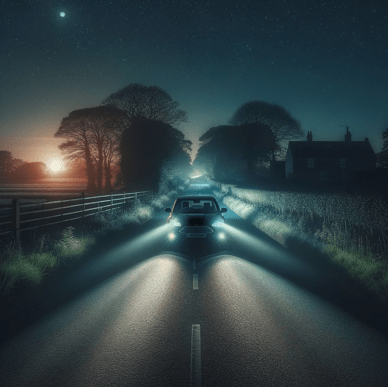
在全黑的環境下駕駛,需要特別的小心和準備。這裡提供了一些基於專家建議的關鍵提示,以確保您在夜間駕駛時的安全。
- 正確使用燈光:夜間駕駛時,確保前後燈都正常運作是法律規定的。定期檢查燈光是否完好,並在日落前一小時開啟近光燈,在日出後一小時才關閉,以確保在路上清晰可見。在無照明的鄉村道路上,可以使用遠光燈以更清楚地看到道路佈局,但遇到其他車輛時要及時切換回近光燈,以免眩目他人。
- 避免凝視迎面車輛:不要直接看向迎面車輛的大燈,其眩光可能暫時損害您的視力。應該注視道路左側並跟隨路邊的白色線條,以保持您的位置。如果眩光過強以致於什麼都看不見,則應該放慢速度,但避免突然停車。
- 保持窗戶清潔:確保您的車窗內外都是清潔的。車窗上的凝結水和外部的污垢都會損害能見度,特別是在對面車輛的大燈照射下。
- 提防弱勢路用者:特別留意兒童、老年人、自行車手和動物。在學校附近和住宅區格外小心,以便有足夠時間應對突然出現的行人。夜間自行車手可能難以發現,特別是如果他們未穿反光衣服的話。
- 定期檢查視力:如果您在夜間行車時視力困難,應考慮進行視力檢查。夜間駕駛眼鏡並沒有科學證明是有效的,有時甚至會降低能見度。
- 避免疲勞駕駛:疲勞駕駛會顯著降低您的駕駛能力。如果感到困倦,請休息一下。對於夜間長途駕駛,安排休息停留並考慮飲用含咖啡因的飲料以保持警覺。
- 提高夜間駕駛技能:對於新手或不適應夜間駕駛的人,可以考慮參加夜間駕駛課程或Pass Plus課程,其中包括夜間駕駛模塊。
- 小心路面障礙物:在黑暗中,坑洼和道路缺陷更難被發現。在照明不足的區域慢行,並更加謹慎以避免事故。
- 緊急情況的準備:攜帶手電筒(最好是頭戴式的),以備夜間故障時使用。在車內備有毯子或保暖衣物、充電的手機以及除霜器或融冰劑,以應對溫度下降。如果車輛故障,請尋找一個安全、光線充足的地方停車,並開啟危險警告燈,等待幫助。
Driving in total darkness requires special precautions to ensure safety. Here are some key tips based on various sources:
- Use Lights Appropriately: It’s illegal to drive at night without properly functioning front and rear lights. Regular checks are necessary to ensure they’re working correctly. Use dipped headlights an hour before sunset and keep them on an hour after sunrise. On unlit country roads, use full beams for better visibility but switch to dipped beams when encountering other vehicles to avoid dazzling them.
- Avoid Staring at Oncoming Vehicles: Don’t look directly at the headlights of oncoming cars as the glare can impair your vision. Instead, look to the left-hand side of the road and follow the white line marking the edge. If the glare is overwhelming, slow down but avoid stopping abruptly.
- Keep Windows Clean: Ensure your windows are clean both inside and out. Condensation and dirt can impair visibility, especially with the glare from oncoming headlights.
- Be Alert for Vulnerable Road Users: Be extra vigilant for children, the elderly, cyclists, and animals, especially in residential areas, near schools, and on country roads. Children and cyclists can be difficult to spot after dark, and nocturnal animals may dart out onto the road.
- Regular Eye Check-ups: If you struggle to see clearly at night, consider getting your eyes tested. Night driving glasses are not scientifically proven to be effective, and in some cases, they may even reduce visibility.
- Avoid Driving When Tired: Tiredness can significantly impair your driving. If you feel drowsy, take a break. For long journeys at night, schedule rest stops and consider caffeinated drinks to maintain alertness.
- Improve Night-Driving Skills: For those new to driving or uncomfortable with night driving, consider taking evening lessons or a Pass Plus course that includes night driving modules.
- Watch Out for Road Hazards: Potholes and road defects are harder to spot in the dark. Drive slowly and be more cautious in poorly lit areas to avoid accidents.
- Emergency Preparedness: Carry a torch, preferably a head torch, for breakdowns at night. Keep a blanket or warm clothing, a charged mobile phone, and an ice-scraper or de-icer in your vehicle. In case of a breakdown, find a safe, well-lit place to stop and use hazard warning lights while waiting for help.
These guidelines, gathered from various expert sources, provide a comprehensive approach to safely navigating the challenges of driving in total darkness.




